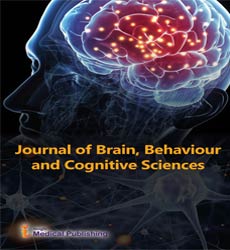Vesicular Expansion at the Rostral End of the Brain Tube
Han Yu*
Department of Neuroscience, Global University, Vancouver, Canada
- *Corresponding Author:
- Han Yu
Department of Neuroscience, Global University, Vancouver,
Canada,
E-mail: ha.a@ualbrta.ca
Received date: May 01, 2024, Manuscript No. JBBCS-24-19466; Editor assigned date: May 04, 2024, PreQC No. JBBCS-24-19466 (PQ); Reviewed date: May 20, 2024, QC No. JBBCS-24-19466; Revised date: May 27, 2024, Manuscript No. JBBCS-24-19466 (R); Published date: June 03, 2024, DOI: 10.36648/jbbcs.7.1.34
Citation: Yu H (2024) Vesicular Expansion at the Rostral End of the Brain Tube. J Brain Behav Cogn Sci Vol.7 No.1: 34.
Description
The mind fills in as the focal organ of the sensory system in all vertebrate and most invertebrate creatures. Made out of sensory tissue, it is regularly situated in the head (a peculiarity known as cephalization), generally close to organs liable for extraordinary faculties like vision, hearing and olfaction. As the most particular organ, the mind is answerable for getting data from the tactile sensory system, handling this data (incorporating thought, cognizance and insight) and planning engine control (counting muscle action and the endocrine framework).
Vertebral segment
Invertebrate minds start from matched segmental ganglia of the ventral nerve string, each answerable for its particular body fragment. Interestingly, vertebrate cerebrums grow pivotally from the midline dorsal nerve rope, shaping a vesicular expansion at the rostral end of the brain tube, which activities concentrated command over all body fragments. Embryonically, all vertebrate cerebrums can be separated into three sections: the forebrain (prosencephalon, further partitioned into the telencephalon and diencephalon), the midbrain (mesencephalon) and the hindbrain (rhombencephalon, partitioned into the metencephalon and myelencephalon). The spinal line, which straightforwardly interfaces with substantial capabilities underneath the head, can be viewed as a caudal expansion of the myelencephalon encased inside the vertebral segment. Together, the cerebrum and spinal line comprise the focal sensory system in all vertebrates. In people, the cerebral cortex contains roughly 14-16 billion neurons, while the assessed number of neurons in the cerebellum goes from 55-70 billion. Every neuron is associated by neurotransmitters to a few thousand different neurons, normally imparting through rootlike distensions called dendrites and long fiber-like expansions called axons. These axons, normally myelinated, convey quick miniature electric sign heartbeats called activity possibilities to target explicit beneficiary cells in different region of the mind or far off pieces of the body. The prefrontal cortex, which controls chief capabilities, is especially well-developed in people.
Sensory tissue
Physiologically, the mind applies incorporated command over the body's different organs. It impacts the remainder of the body by creating examples of muscle movement and driving the discharge of chemicals. This unified control permits quick and facilitated reactions to changes in the climate. While fundamental kinds of responsiveness, like reflexes, can be intervened by the spinal string or fringe ganglia, modern and deliberate control of conduct in light of mind boggling tangible info requires the data coordinating capacities of a brought together cerebrum. The tasks of individual synapses are currently grasped in significant detail, however the manner in which they coordinate in gatherings of millions stays to be completely clarified. Ongoing models in current neuroscience treat the mind as a natural physiology, particular in system from an advanced physiology however comparable in that it gains data from the encompassing scene, stores it and cycles it in different ways. This article looks at the properties of minds across many creature species, with specific regard for vertebrates. It talks about the human mind to the extent that it imparts properties to different cerebrums. The differentiations of the human mind from others are shrouded in the human cerebrum article. Subjects, for example, mind illness and the impacts of cerebrum harm, which are to a greater extent examined in a human setting, are likewise covered there. The shape and size of the cerebrum shift incredibly between species, making it trying to distinguish normal elements. In any case, a few standards of cerebrum design apply across a great many animal groups. A few parts of cerebrum structure are normal to practically the whole scope of creature species, while others recognize high level minds from additional crude ones or separate vertebrates from spineless creatures.
Open Access Journals
- Aquaculture & Veterinary Science
- Chemistry & Chemical Sciences
- Clinical Sciences
- Engineering
- General Science
- Genetics & Molecular Biology
- Health Care & Nursing
- Immunology & Microbiology
- Materials Science
- Mathematics & Physics
- Medical Sciences
- Neurology & Psychiatry
- Oncology & Cancer Science
- Pharmaceutical Sciences
